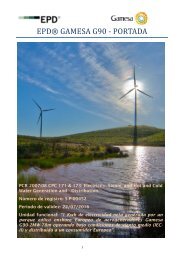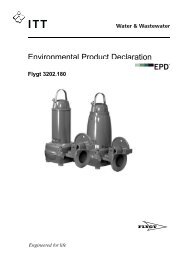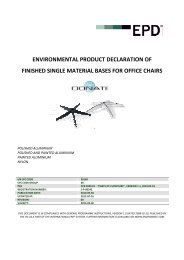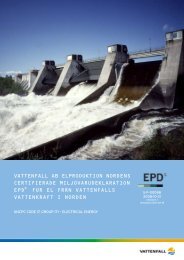Vattenfall aB GeneRatIOn nORDIC CeRtIfIeD enVIROnmental ...
Vattenfall aB GeneRatIOn nORDIC CeRtIfIeD enVIROnmental ...
Vattenfall aB GeneRatIOn nORDIC CeRtIfIeD enVIROnmental ...
Create successful ePaper yourself
Turn your PDF publications into a flip-book with our unique Google optimized e-Paper software.
4 Additional environmental information<br />
The International Commission on Non-Ionising Radiation Protection (ICNIRP), an independent<br />
body consisting of international experts, has however published recommendations 1<br />
regarding acute health problems. The recommendations are based on knowledge about<br />
acute health problems due to changing magnetic fields and propose a limit of 500 μT for<br />
working environment and for the general public a limit of 100 μT at 50 Hz. The EU Council<br />
of Ministers recommends a restriction of exposure to electro-magnetic fields in accordance<br />
with the ICNIRP:s recommendations.<br />
According to ICNIRP available research results on lesions due to long-range exposure, for<br />
example raised risk of cancer, do not suffice to establish limits.<br />
<strong>Vattenfall</strong> follows the precautionary principle, which implies reducing fields that deviate<br />
considerably from normality in each specific case. <strong>Vattenfall</strong> follows ICNIRP’s, WHO’s and<br />
OECD’s work and recommendations in the area.<br />
4.5 Noise<br />
Sound propagation depends on several factors such as medium, frequency, amplitude,<br />
temperature, humidity, wind, and geography. Consequently noise levels from one and the<br />
same source may vary from day to day. It also means that two identical sources of noise<br />
in different locations may give rise to completely different noise levels and propagation<br />
patterns and may be experienced differently.<br />
The most distinguishing outdoor noise from hydropower generation is the sound of streaming<br />
water at above ground stations. These sound levels are, however, lower than preregulation<br />
and more often than not considered pleasant.<br />
Noise levels from transformers are generally moderate (45–60 dB), but the frequencies<br />
are low (80 dB), which under unfavourable conditions can be disturbing at distances<br />
of up to 1 km. At Porjus, levels of 92 dB(A) 2 have been measured at 1 meter, and of<br />
42 dB(A) 2 at 800 meters from the transformer.<br />
Power lines over 70 kV may give rise to noise (corona noise). Sound levels are moderate -<br />
45 dB(A) 2 at 25 meters decreasing rapidly.<br />
1<br />
Guidelines for Limiting Exposure to Time-Varying Electric, Magnetic, and Electromagnetic Fields<br />
(up to 300 GHz), Health Physics Vol. 74, No 4, pp 494-522, 1998.<br />
2<br />
dB(A) indicates that a standard method of measurement has been used where the value has been<br />
corrected with respect to the sensitivity of the human ear at different frequencies.<br />
© <strong>Vattenfall</strong> AB Generation Nordic 2008 42

















